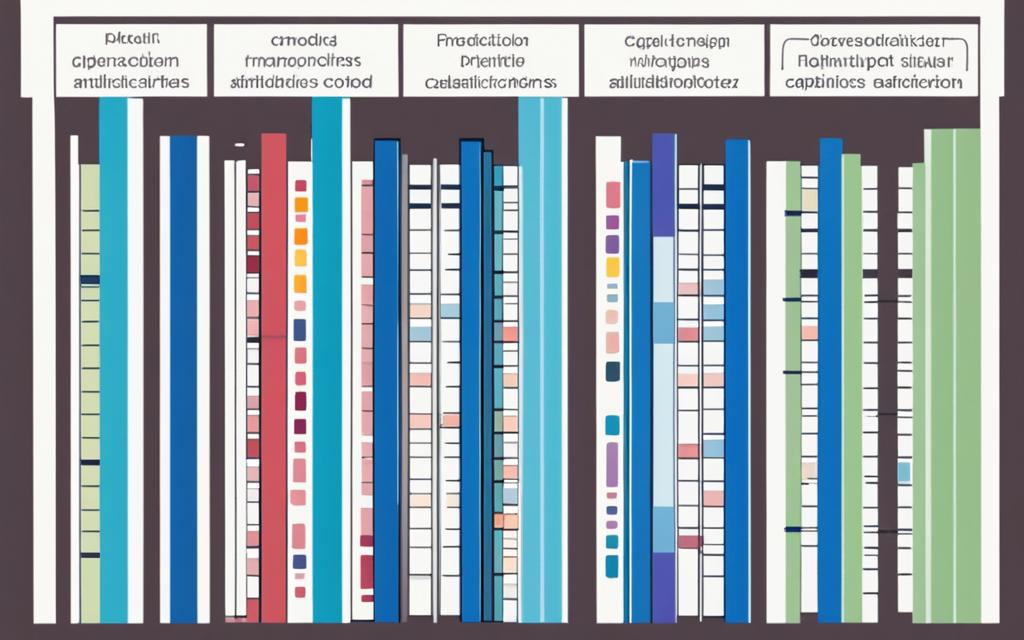Understanding Bipolar Disorder: Symptoms & Care
Understanding bipolar disorder is not simple. This condition brings emotional highs and lows. People with bipolar disorder experience big mood swings. It’s important to know the symptoms and get the right support. This helps those affected live better lives. We aim to teach and support people and their families.
It’s key that everyone understands bipolar disorder. This isn’t just for those who have it, but for everyone around them. Recognizing the signs early can make a big difference. The good news is, treatments are getting better. This gives hope for managing the condition well.
Key Takeaways
- Recognizing bipolar disorder is the first step towards effective management and support.
- Understanding the symptoms is crucial for individuals and their support networks.
- There exists a range of care options that cater to different needs and symptoms.
- Offering bipolar disorder support requires empathy and informed approaches.
- Lifetime management is possible with the right resources and professional assistance.
- Community and societal understanding are essential for destigmatizing the condition.
What is Bipolar Disorder?
Bipolar disorder is more than just mood swings. It’s a challenging mental health issue with ups and downs. These mood changes can affect behavior, energy, and day-to-day activities. It’s key to learn about bipolar disorder and the bipolar spectrum. This knowledge helps us understand and support those who are affected.
The Definition of Bipolar Disorder
Bipolar disorder is a brain disorder that causes extreme mood changes. These aren’t just regular mood changes. The mood shifts in bipolar disorder are intense and can make daily life hard. About 2.8% of US adults face this disorder yearly, showing its common impact.
Understanding the Bipolar Spectrum
The bipolar spectrum covers a range of mood disorders. It includes various forms of bipolar disorder, each different in symptoms and severity. Understanding this spectrum shows why personalized treatment is necessary.
- Awareness of Symptoms: Early recognition of symptoms can lead to better management.
- Understanding Causes: Knowing the causes of bipolar disorder helps in finding treatments. Genetics and environment play a role. This knowledge supports better help systems.
- Educating Others: More knowledge means less stigma around bipolar disorder. It promotes a supportive community for those in need.
Experts are working hard to improve treatments and support for bipolar spectrum and bipolar disorder causes. Their goal is a good life for those dealing with this challenge.
Recognizing the Signs of Bipolar Disorder
Knowing the symptoms of bipolar disorder is very important. It helps with quick diagnosis and effective treatment. This condition causes big changes in mood, like high moments (mania or hypomania) and low ones (depression). Spotting these signs early is key to getting the right help.
- Emotional Highs: People may feel extremely happy, very energetic, or easily annoyed during manic phases.
- Emotional Lows: During depression, there might be deep sadness, little energy, and no joy in usual hobbies.
- Sleep Disturbances: Sleep can be too little during mania or too much in depression.
- Behavioral Changes: Someone may act risky, be hasty, or stay very busy in mania. In depression, they might pull away from friends.
- Cognitive Impairments: It can be hard to focus, remember, or make choices during both highs and lows.
Understanding these signs helps with early help and better self-care or supporting someone else. Noticing mood changes assists in finding what triggers them. This leads to better management plans for dealing with bipolar disorder.
Types of Bipolar Disorder & Their Differences
It’s important to know about the different kinds of bipolar disorder. This helps in handling and treating it better. We’ll look at the main types: Bipolar I, Bipolar II, and cyclothymic disorder. And, we’ll see what makes each one unique.
Bipolar I vs. Bipolar II
Bipolar I involves very high mood swings that last at least seven days. Or, the symptoms could be so strong that the person needs to be in a hospital right away. There’s usually also a period of deep sadness that lasts two weeks or more. Bipolar I can really disrupt someone’s life.
Bipolar II is different because it doesn’t have those intense highs. Instead, there are lower highs called hypomania and periods of sadness. The hypomania isn’t as severe and doesn’t mess up daily life or require a hospital visit.
Cyclothymic Disorder and Other Variants
Cyclothymic disorder, or just cyclothymia, is a lighter version of bipolar disorder. People have mild highs and lows for at least two years, or one year for kids and teens. But these don’t fully match the more intense symptoms of full hypomanic or depressive episodes.
If we talk about Bipolar I and Bipolar II most, it’s still valuable to know about cyclothymic disorder. Each kind has its own set of problems and ways to help deal with them.
Common Causes and Risk Factors for Bipolar Disorder
It’s important to know what causes bipolar disorder and its risk factors. We will look into genetic traits and the effect of stress. Knowing these can help both patients and their families.
Genetic Predispositions
Genes play a big part in bipolar disorder. If a family member has it, your own risk goes up. Knowing this helps us keep an eye out early on.
Environmental Stressors
Life’s tough events can also trigger bipolar disorder. Things like losing someone close, or big changes at work or home. When someone is already likely to get the disorder, these stresses can start mania or depression.
Lifestyle’s Impact on Bipolar Disorder
The way you live can affect how severe bipolar disorder gets. Bad sleep habits or using drugs can make symptoms worse. This makes it harder to handle the disorder.
| Risk Factor | Description | Impact Level |
|---|---|---|
| Family History | Having one or more family members with bipolar disorder | High |
| Stressful Life Events | Exposure to stress through personal or professional areas | Moderate to High |
| Lifestyle Choices | Substance abuse, lack of sleep, poor diet | Moderate |
The Role of Therapy in Bipolar Disorder Management
Managing bipolar disorder effectively often needs a mix of therapies. These are customized to meet individual needs. Through bipolar disorder therapy, people can get better control of their symptoms. This improves how well they live.
Therapy helps not just in acute phases but also offers long-term plans to avoid relapse. We will look at various therapies and their roles in managing this condition.
- Cognitive Behavioral Therapy (CBT)
- Psychoeducation
- Family Therapy
- Interpersonal and Social Rhythm Therapy (IPSRT)
Cognitive Behavioral Therapy (CBT) works well in reshaping negative thoughts and actions. This can greatly improve mood and how a person functions. Psychoeducation lets individuals and their families understand bipolar disorder better. It stresses the need for taking medication as prescribed. Family Therapy examines how family interactions can influence, or be influenced by, a family member with bipolar disorder. It aims to improve talking within the family and reduce stress. Interpersonal and Social Rhythm Therapy (IPSRT), on the other hand, helps keep a regular routine for sleeping, eating, and other activities. This is key to reducing the chances of manic or depressive episodes.
| Therapy Type | Primary Focus | Expected Benefits |
|---|---|---|
| Cognitive Behavioral Therapy (CBT) | Cognitive restructuring | Reduces depressive symptoms, prevents relapse |
| Psychoeducation | Knowledge enhancement | Increases treatment adherence, reduces hospitalizations |
| Family Therapy | Family dynamics | Improves family relationships, reduces relapse triggers |
| Interpersonal and Social Rhythm Therapy (IPSRT) | Daily rhythms management | Prevents mood fluctuations, stabilizes daily functioning |
By adding these therapies into your treatment plan, you can be a big part of managing your bipolar disorder. This leads to better control of the condition and a more stable and happy life.
Bipolar Disorder Medications and How They Work
Understanding treatments for bipolar disorder means looking at various drugs. These include mood stabilizers, antipsychotic medications, and antidepressants. Each type has a role in managing symptoms and improving health. We’ll look into how these medications help and the risks involved.
Mood Stabilizers and Their Function
Mood stabilizers play a key role in treating bipolar disorder. They help control mood swings and prevent extreme highs and lows. Drugs like lithium and valproate are effective in reducing manic episodes. They are vital for managing bipolar disorder.
Antipsychotic Medications
Antipsychotic medications come into play when symptoms are tough or mood stabilizers aren’t enough. Drugs like aripiprazole, olanzapine, and quetiapine treat manic and depressive symptoms. They can be combined with other treatments for better results.
Antidepressants: Benefits and Risks
Antidepressants help with bipolar disorder’s depressive phases. But, they must be used with caution. They can lead to manic episodes or rapid mood changes. So, they’re often prescribed with mood stabilizers or antipsychotics to lessen these risks.
| Medication Type | Primary Use | Common Brands | Potential Side Effects |
|---|---|---|---|
| Mood Stabilizers | Stabilize mood swings | Lithium, Valproate | Weight gain, tremors, cognitive dulling |
| Antipsychotic Medications | Treat severe manic episodes | Aripiprazole, Olanzapine | Drowsiness, weight gain, diabetes risk |
| Antidepressants | Manage depressive phases | Fluoxetine, Sertraline | Risk of triggering manic episodes |
Choosing and managing bipolar disorder medication with a doctor’s help can greatly improve life quality. It helps achieve a more balanced and stable daily routine.

Lifestyle Changes for Living with Bipolar Disorder
Making effective changes in your lifestyle is key for living with bipolar disorder. Start regular routines and focus on sleep hygiene and exercise to better manage bipolar disorder. We will look at ways to make your life more stable.
Importance of Routine
Having a daily routine is very helpful in managing bipolar disorder. A structured day can lower stress and help control your mood. This may help decrease the highs and lows of bipolar disorder.
Include regular meal times, sleep schedules, and time for activities and rest in your routine.
Sleep Hygiene and Exercise
Good sleep habits are crucial for those with bipolar disorder. Bad sleep can set off mood swings. To sleep better, try these tips:
- Avoid caffeine and screens before bed.
- Make your bedroom a cozy place to sleep.
- Keep a regular sleep schedule, even on weekends.
Exercise is also important for managing bipolar disorder. Being active can help you feel less anxious and sad. It also boosts your overall health.
| Activity | Benefits |
|---|---|
| Moderate Exercise (e.g., walking, cycling) | Raises your mood, improves sleep, lowers stress |
| Resistance Training (e.g., weight lifting) | Makes you stronger, increases energy, raises endorphins |
| Yoga | Increases flexibility, cuts down on anxiety, helps control mood |
Identifying and Managing Bipolar Disorder Triggers
Managing bipolar disorder means knowing and dealing with triggers. These are things that can spark mood episodes. Learning what triggers you is key. This knowledge lets you lessen their effect and stay stable.
Bipolar disorder triggers differ for everyone. They usually include stress, not sleeping well, and changes in daily life. Knowing your triggers is the first step in bipolar disorder management. Here are ways to identify them:
- Keep a Daily Journal: Write down your daily life, moods, sleep, and people you meet. You might spot trends that affect your mood.
- Review Your History: Think about past times of high or low moods. What might have started them? Looking back can teach you a lot.
- Work with a Professional: A therapist or doctor can spot triggers you haven’t. They’ll also offer ways to handle them.
Here are strategies to manage triggers:
- Maintain a Routine: A regular schedule can cut down triggers. Try to keep eating, sleeping, and working out at the same times.
- Practice Relaxation Techniques: Since stress is a big trigger, try meditation, yoga, or deep breathing to relax.
- Avoid Substance Abuse: Stay away from alcohol and drugs. They can make symptoms worse and mess with your medicine.
Managing bipolar disorder triggers is unique to each person. It requires trying different methods and constantly checking what’s best. Talking openly with doctors and getting support from family and friends are essential for managing bipolar disorder successfully.
How to Support Someone Living with Bipolar Disorder
Supporting someone with bipolar disorder means learning about the condition. It’s about creating a caring space and using strategies for their highs and lows. As a supporter, you play a key role in their path to stability and health.
Effective Communication Strategies
Bipolar disorder support greatly depends on good communication. It’s important to develop ways to talk with your loved one at all times. Listening well, understanding their feelings, and talking without judgment are key. Learning about symptoms and treatments helps you have better talks.
Dealing with Manic or Depressive Episodes
Dealing with manic episodes takes patience. You should promote a regular schedule, ensure they sleep enough, take their medication, and lower stress. For depressive episodes, giving them a place to share feelings and pushing for professional help if things get worse is crucial. Spotting the early signs of these episodes helps in managing them effectively.
| Episode Type | Signs | Support Strategies |
|---|---|---|
| Manic | Increased energy, reduced need for sleep, euphoria, irritability | Maintain calm, avoid confrontation, encourage routine |
| Depressive | Persistent sadness, lack of energy, feelings of hopelessness, withdrawal | Encourage professional help, offer emotional support, promote physical activity |
The journey of supporting someone with bipolar disorder is complex but fulfilling. Using effective communication and knowing how to handle manic and depressive episodes can make a big difference. Remember, you’re not doing this alone. Look for resources and expert advice to strengthen your support.
Integrating Bipolar Disorder Therapy and Support Groups
When you have bipolar disorder, using both bipolar disorder therapy and bipolar disorder support groups can really make life better. This way, you get the best of both worlds: expert help and understanding from people who know what you’re going through.
Bipolar disorder therapy is about meeting with a mental health expert. They teach you ways to control your feelings and actions. In these meetings, you’ll learn how to handle your symptoms and lessen their effects on your life. Bipolar disorder support groups let you meet others facing the same issues. You’ll find comfort and advice, building a community that gets it.
- Personalized coping strategies from therapy sessions.
- Real-life advice and emotional comfort from support groups.
- Increased awareness and education about bipolar disorder.
- Networking opportunities for additional resources and insights.
This mix of professional therapy and group support tackles both the medical and social sides of bipolar disorder. It’s a full-package approach to dealing with the condition.
By bringing therapy and group support together, you become stronger. You can enjoy life more, despite bipolar disorder’s challenges.
| Therapy Benefits | Support Group Advantages |
|---|---|
| Structured treatment plans | Peer-based understanding and support |
| Professional health monitoring | Shared personal experiences and coping mechanisms |
| Access to latest medical interventions | Emotional and moral encouragement |
Combining bipolar disorder therapy and bipolar disorder support groups makes a big difference. It helps you to better tackle the disorder. You start to see your daily life in a more normal light. This blend has proven to boost wellness and stick with treatments.
Debunking Myths About Bipolar Disorder
To really understand bipolar disorder, we need to clear up the common myths. We aim to focus on challenging stigma and changing the false stories about bipolar disorder.
Separating Fact from Fiction
A lot of myths about bipolar disorder spread because of wrong information. One widespread myth is that it’s just about having mood swings. This oversimplification makes the condition seem less serious. It leads to people being misunderstood and judged incorrectly.
Challenging Stigma and Misconceptions
Stigma creates a huge obstacle to diagnosing and treating bipolar disorder. It makes people feel isolated. This isolation makes it hard for them to get help or support. By talking about and sharing true information on bipolar disorder, we can fight this stigma. We aim to make society more caring and understanding.
| Myth | Fact |
|---|---|
| People with bipolar disorder can’t lead normal lives. | Many people manage their condition well and have fulfilling lives. |
| Bipolar disorder is just an excuse for poor behavior. | Bipolar disorder is a real brain condition that needs care and understanding. |
| Bipolar individuals are always either manic or depressed. | People with bipolar disorder often have periods where their mood is stable. |
Debunking these myths helps create a supportive environment that’s good for everybody. By learning and sharing the truth, we work towards challenging stigma. This helps us support those with bipolar disorder better.
Navigating Bipolar Disorder Resources and Assistance
Identifying and using resources can really help with bipolar disorder management. We will look into how to find professional help. Also, how to make the most of online resources and community support.
Finding Professional Help
It’s key to seek professional help. Consulting healthcare pros who know mood disorders is crucial. They can create a treatment plan just for you. Psychiatrists, psychologists, and therapists can diagnose and provide helpful therapies for managing bipolar disorder.
Utilizing Online Resources and Community Support
Online resources are a big help for those living with bipolar disorder. There are websites for peer support, learning, and finding local therapists. These can really add to the help you get from pros. Plus, community support like groups and workshops lets you share and learn from others facing similar challenges.
| Type of Resource | Description | Benefits |
|---|---|---|
| Professional Counseling | Services offered by certified mental health professionals. | Personalized care, diagnosis, and treatment planning. |
| Online Forums | Platforms for sharing experiences and advice. | Accessible round the clock, anonymity, and a wide range of perspectives. |
| Community Groups | Local or virtual meetings focusing on support and recovery. | Real-life interaction and long-term networks of support. |
Both offline and online bipolar disorder resources are crucial. They provide a lot of support and help improve recovery. Using these resources wisely can lead to a better life.
Conclusion
Bipolar disorder is complex, requiring tailored care and treatment. Effective bipolar disorder treatment involves many steps. This includes medication, therapy, lifestyle changes, and ongoing support. People with this disorder need to have the right resources. This helps them make smart decisions about their health.
Knowledge is a powerful tool for those with living with bipolar disorder. Understanding the disorder helps them manage their symptoms. They can work towards a more stable life. The path to balance is tough. Yet, with patience, persistence, and proper support, it’s possible to manage bipolar disorder well. Using what they’ve learned from therapy or support groups can empower them.
Being proactive about your condition can change your life and those around you. Finding the right bipolar disorder treatment and a strong support network is key. It leads to a hopeful journey towards balance. Remember, it’s a constant process of learning and adapting. Each challenge is a chance to grow and renew yourself.
FAQ
What are the main symptoms of bipolar disorder?
Bipolar disorder’s main symptoms are extreme mood swings. These swings go from highs (mania or hypomania) to lows (depression). During manic phases, one may feel very happy, irritable, have a lot of energy, and need less sleep.
Depressive phases bring sadness, hopelessness, low energy, and changes in sleep and appetite.
How is bipolar disorder treated?
Treatment often includes medication and therapy. Medicines like mood stabilizers and antidepressants help. Lifestyle changes and support groups are crucial too.
Can bipolar disorder be caused by external factors?
Bipolar disorder’s cause is complex. It involves genetics and environment. Stress or traumatic events might trigger it.
What is the difference between Bipolar I and Bipolar II?
Bipolar I disorder includes severe mania and depression. Bipolar II features less intense mania, called hypomania, and depressive episodes.
How do lifestyle changes impact the management of bipolar disorder?
Lifestyle changes are very helpful. This includes sticking to a routine, sleeping well, exercising, and managing stress. These improve mood and well-being.
How can therapy help with bipolar disorder management?
Therapy aids in understanding the condition. It helps manage symptoms and stress, improves relationships, and supports emotional well-being.
What should you do if you suspect someone has bipolar disorder?
Encourage them to get professional help. Be supportive and understanding of their journey through diagnosis and treatment.
Why is it important to identify and manage bipolar disorder triggers?
Knowing and handling triggers reduces episode frequency and severity. It helps individuals maintain stability.
How can I support a loved one living with bipolar disorder?
Learn about the condition, listen without judgment, and be patient. Encourage treatment and learn how to help during episodes.
Are there any misconceptions about bipolar disorder?
Yes, people mistakenly think mood swings aren’t serious or that one can “snap out of it”. The stigma around unpredictability or danger is also wrong and hurtful.
What types of professional help are available for bipolar disorder?
Help comes from psychiatrists, psychologists, and support groups. Online resources and community support are valuable too.
Where can one find bipolar disorder resources and assistance?
Look for help at mental health clinics, hospitals, or online. National organizations like NAMI offer guidance. Healthcare providers can direct you to local support.







